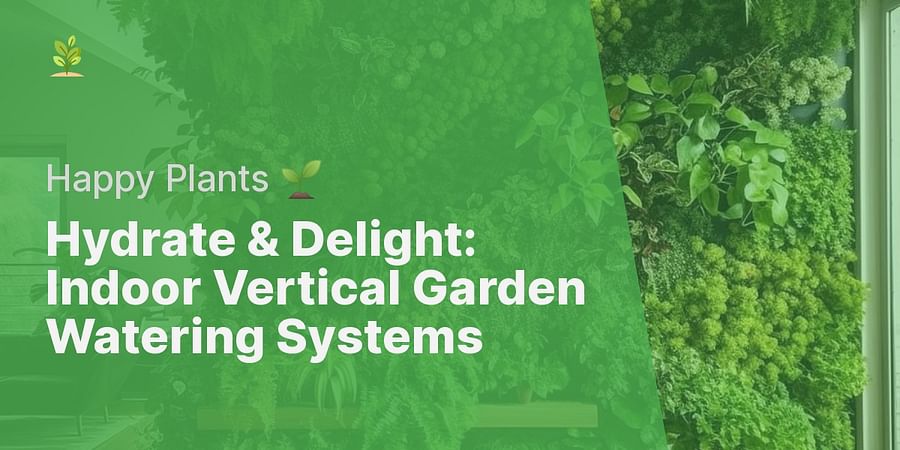Indoor Vertical Garden Watering Systems: Keeping Your Plants Hydrated and Happy

Imagine stepping into your living room, breathing in the fresh, oxygen-rich air, and being surrounded by a lush oasis of greenery cascading down your walls.
Welcome to the world of indoor vertical gardens!
This innovative way to grow plants vertically indoors adds a touch of nature to your home and maximizes the use of space.
But what's the secret to maintaining a thriving, low-maintenance vertical garden? The answer lies in an effective watering system. Just like us, plants need hydration to survive and flourish.
However, watering a vertical garden is not as straightforward as watering regular potted plants. It requires a special system that ensures every plant in your vertical garden receives the right amount of water.
So, ready to learn about the best vertical garden watering solutions and how to keep your indoor plant hydration at optimal levels? Let's dive in!

Just as humans have different hydration needs, our leafy friends also have unique thirst-quenching requirements. For instance, strawberries in your indoor vertical garden prefer consistently moist soil, while cucumbers are heavy drinkers and need regular watering to prevent their fruits from becoming bitter.
Conversely, Zucchini requires a moderate amount of water, but it's essential to avoid wetting the leaves to prevent diseases.
Understanding the water needs of your plants is crucial in maintaining a thriving indoor vertical garden. It's like being a bartender for your green buddies, serving each one their preferred cocktail of life-giving water.
But remember, overwatering can be just as harmful as underwatering. Are you wondering how to strike the right balance? We've got you covered in our comprehensive comparison of vertical garden watering systems.

Let's dive deeper into the world of indoor vertical garden watering systems, a crucial element in the success of your verdant oasis. Think of these systems as the lifeblood of your vertical garden, delivering essential hydration to your plants, from strawberries to zucchinis.
But how do they work?
Well, the answer is as diverse as the plants you're growing. Some systems use drip, gently releasing water at the root level, perfect for thirsty plants like cucumbers. Others employ a wicking technique, ideal for low-maintenance vertical gardens, where capillary action draws water up to the plants.
Then there are self-watering pots, a godsend for the busy urban gardener.
Choosing the right system depends on your plants, lifestyle, and gardening goals. Curious about the benefits of each method? Check out our comparison of vertical garden irrigation methods.
Now that we've discussed the different types of indoor watering systems let's look at them in action. This video demonstrates how to set up an automatic watering system for a vertical garden.
As you can see from the video, setting up an indoor vertical garden watering system is a straightforward process. In the next section, we will provide a detailed step-by-step guide on how to set up your watering system.
Now that we've covered the basics of indoor vertical garden watering systems, let's dive into the practical part. Here's a step-by-step guide to help you set up your system.
Learn more about 🌱 Your DIY Guide to Setting Up an Indoor Vertical Garden Watering System 🌿 or discover other Plant Handy guides.
Congratulations! You've successfully set up your indoor vertical garden watering system.
Remember, the key to a healthy garden is regular monitoring and adjustments. Now, let's move on to how you can maintain your system to ensure it continues to function effectively.

Like a well-oiled machine, your indoor vertical garden system demands regular upkeep to ensure smooth operation. Remember, the heart of your vertical garden is its watering system.
It's not merely about watering your plants; it's about delivering the right amount of moisture at the right time to the right place.
To keep your watering system functioning optimally, here's a handy checklist for routine maintenance:
Now that you're armed with this checklist, let's move on to some common mistakes you should avoid in maintaining your indoor vertical garden watering system.
It's easy to get carried away, like a child in a candy store, when setting up your indoor vertical garden watering system. But remember, it's not about quantity but quality; too much water can drown your plants.
We've all been there, enthusiastically over-watering and, ultimately, causing root rot. Well, let's fix that.
Also, tap water can seem convenient, but it's not always the best choice for your plants. Why? Because tap water contains chemicals like chlorine, which can harm your indoor garden plants. So, consider using filtered water instead.
And don't forget about your indoor plant's drainage needs. A common mistake is neglecting proper drainage, leading to waterlogged plants. To avoid this, ensure your indoor vertical garden system has adequate drainage.

Indoor vertical garden watering systems are essential for the health and vitality of your plants. With this guide's insights, you are well-prepared to maintain a thriving green oasis in your living space.
Remember that indoor vertical gardening is a dynamic and rewarding pursuit. As you experiment with different watering systems and adapt them to your specific needs, you'll enjoy the beauty of your vertical garden and deepen your connection with nature and the satisfaction of nurturing your lush oasis.
Happy gardening, and may your indoor vertical garden remain hydrated and happy!
Now that we've highlighted some common mistakes in maintaining indoor vertical garden watering systems let's answer some frequently asked questions to clarify these points further.
This knowledge lets you keep your indoor vertical garden hydrated and happy. Remember, a well-maintained watering system is key to a healthy garden!
Post a comment